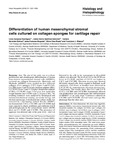Differentiation of human mesenchymal stromal cells cultured on collagen sponges for cartilage repair

Use this link to cite
http://hdl.handle.net/2183/30668
Except where otherwise noted, this item's license is described as Creative Commons Attribution 4.0 International Licence (CC-BY 4.0)
Collections
- Investigación (FCS) [1293]
Metadata
Show full item recordTitle
Differentiation of human mesenchymal stromal cells cultured on collagen sponges for cartilage repairAuthor(s)
Date
2016Citation
Sanjurjo-Rodríguez C, Martínez-Sánchez AH, Hermida-Gómez T, Fuentes-Boquete I, Díaz-Prado S, Blanco FJ. Differentiation of human mesenchymal stromal cells cultured on collagen sponges for cartilage repair. Histol Hispathol. 2016;31(11):1221-1239
Abstract
[Abstract] Aim: The aim of this study was to evaluate proliferation and chondrogenic differentiation of human bone-marrow mesenchymal stromal cells (hBMSCs) cultured on collagen biomaterials.
Materials and methods: hBMSCs were seeded on five different collagen (Col) sponges: C1C2 (types I and II Col), C1C2HS (types I and II Col plus heparan sulphate (HS)), C1C2CHS (types I and II Col plus chondroitin sulphate (CHS)), C1-OLH3 (type I Col plus low molecular weight heparin) and C1CHS (type I Col plus CHS). The resulting constructs were analyzed by histological and immunohistochemical staining, molecular biology and electron microscopy. Col released into culture media was measured by a dye-binding method Results: hBMSCs on biomaterials C1C2, C1C2HS and C1C2CHS had more capacity to attach, proliferate and synthesize Col II and proteoglycans in the extracellular matrix (ECM) than on C1-OLH3 and C1CHS. The presence of aggrecan was detected only at the gene level. Total Col liberated by the cells in the supernatants in all scaffold cultures was detected. The level of Col I in the ECM was lower in C1-OLH3 and that of Col II was highest in C1C2 and C1C2HS. Electron microscopy showed differently shaped cells, from rounded to flattened, in all constructs. Col fibers in bundles were observed in C1C2CHS by transmission electron microscopy.
Conclusions: The results show that Col I and Col II (C1C2, C1C2HS and C1C2CHS) biomaterials allowed cell proliferation and chondrogenic-like differentiation of hBMSCs at an early stage. Constructs cultured on C1C2HS and C1C2CHS showed better cartilage-like phenotype than the other ones.
Keywords
Tissue engineering
Osteoarthritis
Mesenchymal stromal cells
Biomaterials
Chondrogenesis
Osteoarthritis
Mesenchymal stromal cells
Biomaterials
Chondrogenesis
Editor version
Rights
Creative Commons Attribution 4.0 International Licence (CC-BY 4.0)
ISSN
0213-3911






